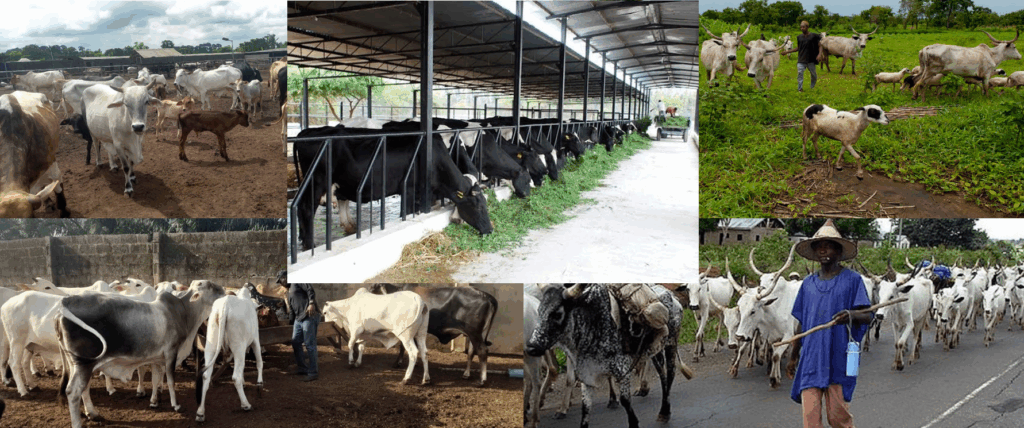As Nigeria pushes for food security and sustainable agriculture, cattle farming continues to play a vital role in the country’s economy and nutritional health. From beef to dairy, hides, and manure, cattle offer multiple income streams. However, the age-old debate between open grazing and zero grazing has continued to gain national attention due to rising land conflicts, changing climates, and the need for modernization. In this article, we examine both systems, their implications, and which approach is better suited for today’s Nigeria and Africa at large.
What is Open Grazing?
Open grazing is the traditional system where herders move cattle across open fields and sometimes across state or national boundaries in search of pasture and water. In Nigeria, this is common among Fulani herdsmen and other nomadic communities.
Advantages of Open Grazing
- Low cost of operation (no need to buy feed)
- Access to natural pasture and water sources
- Encourages traditional livestock knowledge and herding culture
Disadvantages of Open Grazing
- Frequent conflicts between herders and farmers
- Uncontrolled breeding and poor animal health management
- High exposure to diseases like foot-and-mouth disease
- Insecurity and cattle theft
- Land degradation and overgrazing
What is Zero Grazing?
Zero grazing involves raising cattle in a controlled area where feed, water, and veterinary care are provided. Cattle do not roam for food—they are fed cut grass, silage, concentrate, or formulated rations.
This system is common in commercial beef and dairy farms around the world and is gaining traction in Nigeria.
Advantages of Zero Grazing
- Efficient feed use and faster weight gain
- Reduced conflicts with neighboring crop farmers
- Better animal health monitoring and controlled reproduction
- Enables value addition through milk, cheese, and meat processing
- Ideal for urban or peri-urban farmers with limited land
Disadvantages of Zero Grazing
- High capital investment in housing and feeding infrastructure
- Requires technical knowledge on feed formulation and herd management
- Constant water and power supply needed
Comparing Open Grazing vs Zero Grazing
| Feature | Open Grazing | Zero Grazing |
| Land Requirement | High (communal or mobile) | Low to Moderate |
| Initial Investment | Low | Moderate to High |
| Disease Exposure | High | Lower (if managed well) |
| Conflict Potential | Very High | Very Low |
| roductivity | Low and inconsistent | High and measurable |
| Management Complexity | Low | High (but more rewarding) |
Which System Is Best for Nigeria?
Given the realities of population growth, urban expansion, and climate change, the open grazing model is becoming increasingly unsustainable. Land is no longer readily available for unregulated animal movement, and farmer-herder clashes have become one of Nigeria’s biggest security concerns.
Zero grazing, on the other hand, offers a modern, productive, and conflict-free solution to commercial cattle farming. It aligns with national goals to:
- Improve food production
- Promote private-sector driven agriculture
- Attract youth and women into livestock agribusiness
Practical Recommendations for Farmers and Policymakers
- Start Small with Semi-Zero Grazing: Farmers can use available land to grow fodder and tether animals in paddocks.
- Government Support: Policies and incentives should support ranch development, land access, and livestock extension services.
- Training and Capacity Building: Farmers need to be trained in feed production, animal health, breeding, and record-keeping.
- Private Sector Investment: Agripreneurs can invest in mini-ranches, feed mills, and veterinary services.
- Conflict Resolution Frameworks: Mediation and land use mapping can reduce community tensions.
Case Studies: Zero Grazing in Kaduna
Harmony Farms in Okun Owa, Ogun State, stands out as a successful model for zero-grazing cattle farming in Nigeria, significantly enhancing productivity in meat and milk production. By confining cattle in specialized enclosures and supplying balanced, nutritious feeds cultivated on-site, the farm has overcome traditional challenges such as seasonal feed shortages, disease outbreaks, cattle rustling, and land degradation. This innovative approach has improved profitability, promoted environmental sustainability, and attracted interest from local and international investors and policymakers, positioning Harmony Farms as an inspiring example for livestock enterprises across Ogun State and beyond.
In southern Kaduna, an innovative cooperative of determined young cattle farmers joined forces, pooling their limited resources and expertise to establish a thriving zero-grazing dairy farm. Leveraging essential support and guidance from a local NGO, they constructed a practical yet robust cattle shed, strategically planted high-yielding Napier grass, and meticulously implemented daily milk collection processes. Remarkably, within just one year, their hard work translated into tangible results, consistently supplying over 300 liters of fresh, hygienic milk each week to nearby urban markets. Their success story exemplifies a conflict-free, environmentally sustainable, and economically rewarding model—effectively showcasing how modern, efficient farming practices can positively transform rural livelihoods and enhance food security in Nigeria.
Conclusion
Cattle farming in Nigeria urgently needs transformation. Although open grazing may have sustained livestock production historically, contemporary challenges such as climate change, resource scarcity, population growth, and persistent farmer-herder conflicts demand a shift towards controlled, sustainable, and commercially viable systems. Zero grazing isn’t merely a passing trend—it’s the essential path forward for livestock farming in Nigeria and across Africa.
By fully embracing zero-grazing practices, cattle farmers can significantly enhance productivity, mitigate risks, lower production costs, and foster investor confidence. Early adopters of this innovative model will position themselves as industry leaders, ensuring greater profitability, environmental sustainability, and long-term resilience. The transition might require effort, resources, and patience, but the rewards will be transformative. Simply put, the future of profitable cattle farming belongs to those who proactively adapt today.


